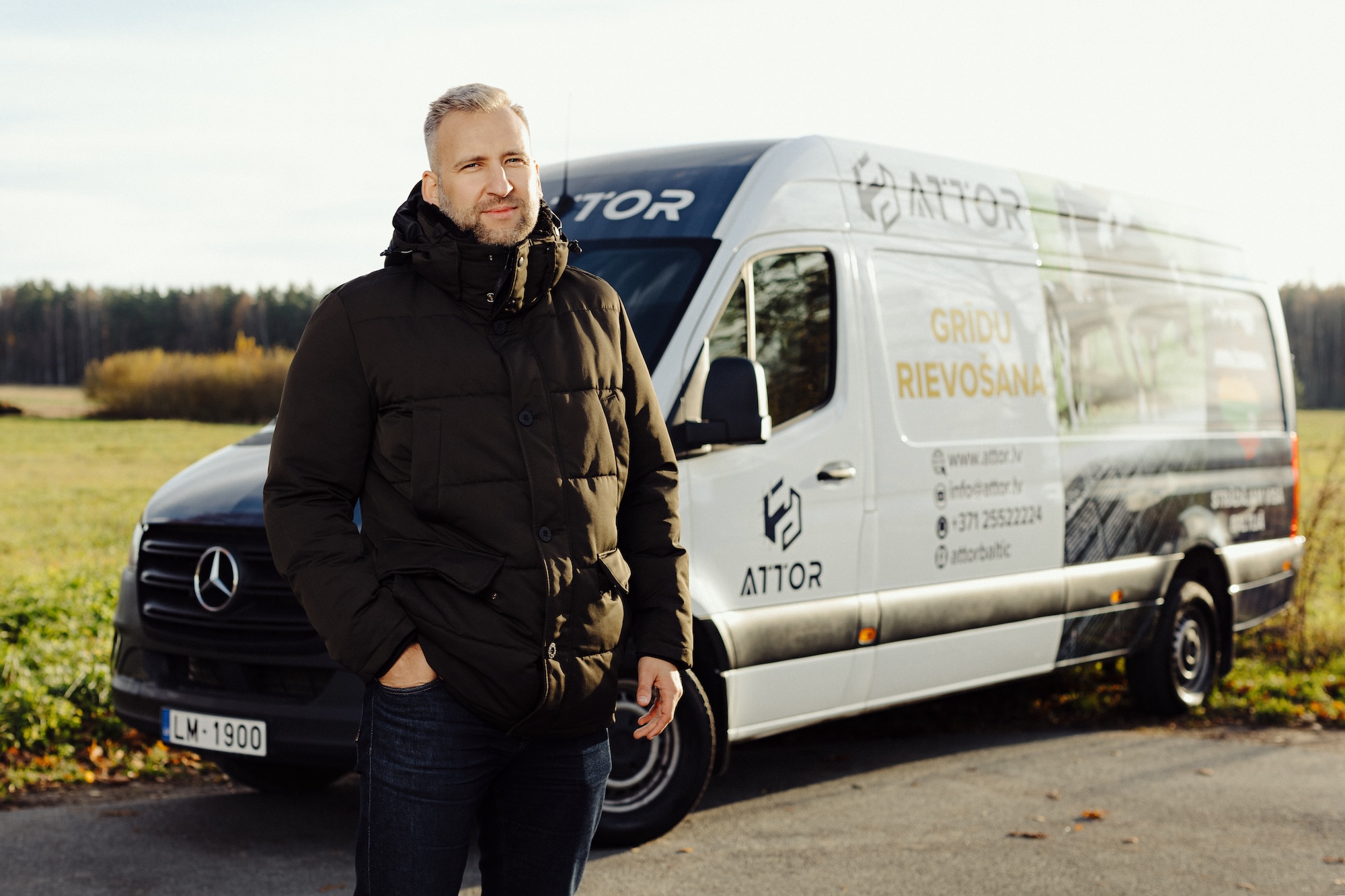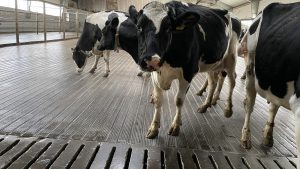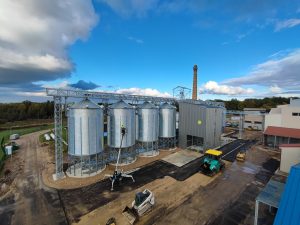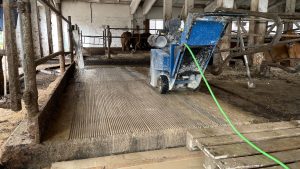Interview with Jānis Hāns, founder and manager of ATTOR; published in SAIMNIEKS magazine, DEC 2023
PREPARED BY: Elina GRASE. PHOTO: Kristaps LAPIKS
Construction company Attor specializes in concrete floor grooving and full-cycle construction services with a specialization in agricultural structures. About the company's experience and development we interviewed Attor founder Jānis Hāns.
- Please introduce with Attor.
- I have been working in the construction industry since my first job. Therefore, founding my own company was a natural result. I used the acquired experience and contacts to start my own business. Attor was founded in March 2011.
We started with smaller projects, but soon after we were entrusted with the construction of two private houses. We continued the implementation of similar construction projects until 2015, when we received the next big project - the construction of an apartment building in Old Riga, Kalēju Street. For another two years, we continued the reconstruction of office buildings, but the biggest professional challenges were strengthening the structures of buildings in a state of emergency in Old Riga.
In 2017 we started collaboration with Poultry fabric Kekava. It marked the further direction of the company's activities. They trusted us, we proved ourselves. That's how the cooperation was established, which continues even now.
The next agricultural building construction project also came to us organically. It all started with the fact that we also offered rental of tractor equipment for additional construction solutions. I took it to the farms myself, that's how I got to know the farmers, who during the negotiations decided to entrust us with various construction works. Since 2017, we have built and reconstructed more than 10 cattle and poultry shelters.
Ltd Attor offers full-cycle agricultural building construction services, in other words, from idea to realization. We can provide design, which is carried out by our long-term cooperation partner, we help with the attraction of EU funding, and we provide full-cycle construction services until the construction is put into operation.
A separate department of our company deals with casting and grooving of concrete floors. We are the only ones in the Baltics to perform professional grooving of concrete floors by Trakrite Global methods. The quality of our service can be assessed on more than 50 farms in Latvia, Lithuania and Estonia with a total of 45,000 m2 grooved floors.
When the solar panel hype started in Latvia, we also installed several solar panel parks. True, their installation is now profitable, because the prices for panels and assembling materials have become even 50% lower. For example, a solar park that was offered to be installed on the market less than a year ago for 11 thousand EUR, now it is possible to build for 6 thousand EUR. Taking into account the unstable geopolitical situation, oil and gas prices may rise at any moment, which will directly affect the price of electricity. Therefore, I recommend that farms become at least partially independent from the electricity market.
– Why have you chosen to move from the construction of multi-apartment houses to agricultural buildings?
– Apartment buildings are typical and do not differ much from each other, but agricultural buildings are different, with different functions. At one moment we build a farm, at another a reception complex, sometimes we need to build silos, other times silage pits. The construction process is simpler, but the quality requirements are still consistently high. There are specifics that need to be known.
It gives me satisfaction to meet my client in person. Long after the project is finished, I can call the owner and get feedback. We can be proud of the fact that we have never been to a customer to perform a warranty repair.
– What kind of structures do you offer farmers?
– We can practically build everything that a farmer wants and that is designed. There are different solutions for how to build, for example, silage pits - made from prefabricated structures, with straight or sloping walls, and barns can also have wooden or metal structures, a roof made of sandwich panels or ranil. We can implement different solutions, but in order for us to build correctly, the client has to do preparatory work and the designer has to professionally prepare the project according to the latest trends in the agricultural industry.
– What have been the most important construction projects of the company's agricultural experience?
– I would like to highlight the bird habitat reconstruction project Poultry factory Kekava, where the construction period was reduced from the planned six months to five, because there is a certain cyclicality in poultry farming, which must not be disrupted - the chickens must be moved from the hatchery to the aviary at the right moment. We are proud that we accepted and fulfilled this challenge.
In 2022, we implemented an unprecedented project for our team - the construction of a legume pre-processing complex Aloja Starkelsen. One of the biggest challenges in the implementation of the project was the availability of building materials and the rising prices. However, in spite of that, we implemented the project within the specified deadlines and with quality.
- Why did you decide to become representative of the patented Trakrite Global method in the Baltic countries?
– In one of the first agricultural farms we built, the owner had seen a particular method of grooving concrete floors and wanted exactly such a solution on his farm. I had promised that I would create one, and my basic business principle is to deliver on what I have promised.
Turned out that the owner had chosen Trakrite Global solution. After contacting the company's representatives, we decided to purchase a grooving machine. At that point, we had no future plans to use the equipment in other facilities.
After the first farm floor grooving we did at the end of 2020, the positive feedback reached other farms and we started receiving new floor grooving requests. Then we realized that there was interest and included the floor grooving service in our offer.
– What has been your experience working with Trakrite Global method in farms in the Baltic countries?
– We started working with this technology in 2020 and at first we did not popularize that we offer it, because my position has always been that we must first learn something properly and then we can offer it in full. The information spread only by word of mouth, especially in Estonia, where the owners quickly understood and were able to appreciate the positive changes brought by a seemingly small improvement - properly grooved floors. In Latvia, we started to fully offer grooved concrete floors only at the end of 2022.
We learned the technology from its creator, Carl Burgi, who has devoted many years to researching cow hoof health, implementing proper practices on farms in the US and elsewhere in the world. He is also the author of recommendations on farm floor and cow hoof health. These recommendations are based on clinical and academic research conducted by the University of Wisconsin-Madison. Dairyland iniciatīvas.
Trakrite Global the established method of grooving concrete floors determines the exact technology, but in short - in a new floor that has not yet been grooved, the most important thing is a sharp edge of the groove at an angle of 90° and the correct distance between the grooves so that the nail has somewhere to grab. If the groove is made in a wet floor and in a V shape, the adhesion between the concrete and the nail is not formed and the cow cannot move safely and comfortably.
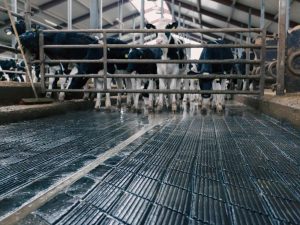 With Mini Groove 20, 26 and 35 we save floors that have already been grooved before, but the grooves do not fulfill their function. Mini Groove solution performs its intended functions very well, but the best result is obtained in new floors by immediately cutting out the deep grooves after Deep Groove metodes.
With Mini Groove 20, 26 and 35 we save floors that have already been grooved before, but the grooves do not fulfill their function. Mini Groove solution performs its intended functions very well, but the best result is obtained in new floors by immediately cutting out the deep grooves after Deep Groove metodes.
It should be taken into account that after correcting the floor, the cows' nails will wear out faster, so it is advisable not to do the grooving of the floors immediately after trimming the nails.
– Are there any prerequisites for grooving concrete floors in the barn?
– It is most appropriate to groove the floors when a new floor is laid or a new building is built. Floors should not be grooved in wet concrete, because then the quality suffers. Unfortunately, it is often necessary to perform grooving of the floors soon after the complex has been put into operation. Currently the anti-record is in six months. In the farm, floor grooving has been done in wet concrete and the floor is damaged. The good news - any floor can be improved!
Grooving of floors can be done gradually. I advise clients to start with at least a small part of the barn, for example, grooving the aisles for one group of cows or only the areas where the cows move the most and are at the highest risk of slipping. Then the customer can assess for himself what effect the grooves give.
- You are also Abbi-Aerotech ventilation solutions' official representative in Latvia.
– There is currently an ongoing training and research process regarding Abbi-Aerotech technologies. This month Abbi-Aerotech representative is visiting. He will help us learn about their solutions. We want to check how they work and what is the best solution for farms in Latvia. In the spring of 2024, we will have completed this process and will be able to confidently provide farms with the best ventilation solutions.
In order to choose the right ventilation solution, you need complete information about what and how many livestock will be in this barn, how high the side walls are and what are the additional natural ventilation solutions in the barn. Only by evaluating all these aspects can the client be offered the most suitable solution.
– What are your observations about the construction industry in the agricultural structures?
– I have noticed a trend where the builder's initial cost quote may be incorrect, resulting in the actual final cost increasing by 8% or more. A farmer must be very careful when choosing a construction company.
It should be remembered that the builder, who is ready to build the cheapest, will not do so at the expense of his own profit, but at the expense of the quality of the work, or these costs will be added to the additional estimate. For example, if the cost of concrete grooving is 8 EUR/m2, then it also costs like that. If a builder offers it for 5 EUR/m2, then he is most likely planning to do it in wet concrete or do grooving work with inappropriate equipment, which I definitely do not recommend. I can guarantee that the grooves will have to be cut again afterwards and unfortunately the cost will be double.
We still cooperate and consult on the best solutions not only in relation to floor grooving, but also on farm equipment with Trakrite Global founder Carl Burgi. He emphasizes that in order to achieve a high milk yield, it is necessary to provide such conditions when the cow eats and sleeps a lot, therefore the sleeping places must be comfortable. Quality mattresses are important and the passages must be safe so that the cow is not afraid to go to the feed table and water trough. If a cow knows that her feet will slip when she gets out of her bed, she will be afraid and will probably eat and drink less.
I have observed that the equipment sold to the farmer does not always meet the needs of the farm, and there are problems with the quality of the after-sales service. Sellers are interested in selling the biggest, most expensive equipment possible, often without considering that it exceeds the capacity of the farm or does not provide adequate conditions for it. As an example, I can mention fans with spray systems, which require very high quality water, therefore a very good, adequate water treatment plant, without which the water spray nozzles will clog very quickly. Most of the water on the farm is obtained from a deep well, where the water has a high iron content. I have also seen farms where a misting system is connected to the water troughs. This, in my opinion, is absurd when the water consumption of the sprinkler system is about 200 l per day, but one cow drinks about 100 l per day. If we connect the misting system to the same water pipe that is used to water the cows, we cannot expect that the water system will be able to purify such a large quantity.
The last topicality of dairy farming, which, in my opinion, will soon enter Latvia as well and will gain more popularity than cooling cows, will be the provision of good quality air, where manure management plays a major role. I believe that soon the scrapers in the manure aisles and the manure shafts will be replaced by a tractor with a manure vacuum pump. Manure shafts create an unpleasant environment, odors are released from it, and therefore the air quality in the barn decreases, especially in hot weather.
– You have worked with various farms in the Baltic States. What observations have you made?
– The positive thing is that more and more owners are aware of the extent to which favorable conditions in the barn - floors, ventilation and other additional equipment - affect the safety, comfort and general health of livestock.
In each Baltic country, the owners' visions for the development of their farms differ. In Lithuania, almost all of them are old-type farms and they are reconstructed relatively little. In Latvia, they are trying to find a middle ground - old farms are often reconstructed, unfortunately, also without taking into account that, for example, the height of the farm does not correspond to the existing trends. This, in my opinion, is not the right solution, because the owners invest significant funds in the reconstruction of the old farm, not understanding that the construction of a new residence is only slightly more expensive, but in the long run the costs will balance out. On the other hand, Estonia has a lot of new, big, modern farms, fans are visible everywhere we've been. Perhaps they take more into account foreign experience, perhaps Estonian designers are also influenced by this trend. Every designer has their own style .. I think that designers are very important, because I see significant differences between farms in the regions of Latvia.
In my opinion, farms in Latvia should think more about biosecurity in barns. Of course, there are farms where everything is in order, many are thinking about it, but have not fully implemented it. For comparison, in Estonia it is taken into account by all farms, in Latvia maybe 30%. In Estonia, you are not allowed to enter the farm without covered, clean clothes, they are disinfected before entering the barn. They pay a lot of attention to prevent diseases from being carried from farm to farm, mainly hoof diseases.
– What news can be expected from Attor?
– It is very important to me that we are able to offer our customers only self-tested solutions. As I mentioned earlier, we are currently conducting a research and training process for ventilation solutions. As soon as we are sure that we can provide our customers with the highest quality service, we will offer it to the market.

